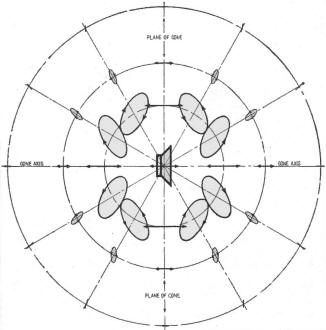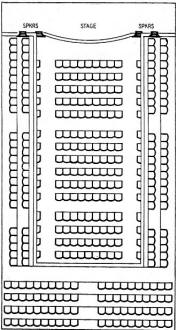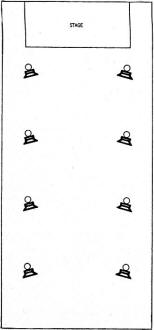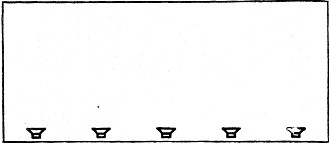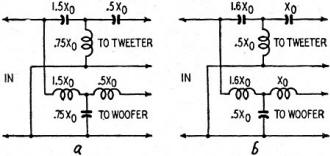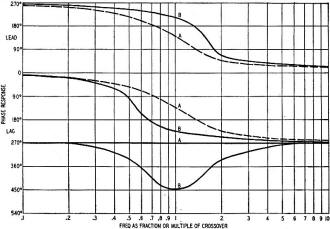Speaker Phasing and Dissociation Effect |
|
While the wavelengths involved are a bit longer (ok, a lot longer) with audio than with radio signals, the effects of constructive and destructive interference due to the multipath phenomenon are fundamentally the same. Author Crowhurst goes into detail about phasing and the dissociation effect. Dissociation has to do with being in a region of ambiguity regarding the angle of arrival of a wavefront due to a combination of signal phase and amplitude combinations, and the listener's location relative to the source. Again, these are the same issues that cause problems with radio receivers, particularly on moving platforms like cellphones while travelling in a car or walking down the street. Radars and electronic warfare systems do a lot of number crunching trying to sort out angle of arrival information. Oh, and you can also learn something worthwhile about how to arrange your home entertainment system speakers by reading this as well. Speaker Phasing and Dissociation Effect By N. H. Crowhurst Keeping the apparent sound source in the correct place calls for careful phasing checks It is evident from correspondence the author has received since his article "Loudspeaker Crossover Design" appeared in the July issue of Radio-Electronics, that many people have recognized the phenomenon called "dissociation effect" without fully understanding its mechanism. To understand the behavior of sound waves we must have the relative wavelengths of audio frequencies clearly in mind. Acoustic waves travel approximately 1,100 feet per second in free air so the length of one wave at a frequency of 1,000 cycles is a little over 1 foot. Lower frequencies have longer waves, while the wavelengths at higher frequencies are shorter. Our Sense of Direction Next we must see how it is possible for us - equipped with only two ears - to determine the direction from which a sound originates. A single ear can give only a limited sense of direction because the spiral communicating channel between the outer ear and the mechanism of the inner ear eliminates the external directivity. Directional sensitivity must be a function of the interpreting faculty of the brain derived by comparing the nerve impulses received from both ears. Is this ability to discriminate based on the intensity relationship or on the phase relationship between the two ears? The difference in intensity between sounds reaching the two ears from a given direction in free space depends on the obstructing effect (diffraction) of the head. This effect increases with frequency, so the intensity on one side is greater at high frequencies than at low frequencies. The phase difference is also greater at high frequencies, because low-frequency waves are much longer than high-frequency waves and change less in the short interval between their times of arrival at the two ears. So the fact that we are more sensitive to the direction of origin of sounds at higher frequencies can be explained by either the intensity-difference or the phase-difference theories. Our subconscious probably utilizes both effects to some degree, but the dissociation effect makes it quite evident that the phase relationship between sounds received by our two ears is the more important of the two. To prove this, we need to understand a little more about sound waves and their propagation. It is well known that a cone loudspeaker working without any kind of baffle or cabinet loses its effectiveness at low frequencies because air escapes around the edge of the cone. (When the cone is moving forward, air particles around the rim rush backward into the partial vacuum behind the speaker.) But what happens to other air particles farther away from the speaker? Fig. 2 - Plan of auditorium that presented a serious problem in acoustics. Proper phasing of speakers solved it. Fig. 3 - Another speaker layout that calls for a special phasing technique. Fig. 1 is a diagram of air-particle movement (somewhat exaggerated) at various points surrounding the speaker. Particles along the cone axis move back and forth along straight lines radiating from the source. On either side of the axis the particles spin in elliptical paths which grow shorter and narrower as the distance from the speaker increases. At extreme distances these ellipses flatten to straight lines which also radiate from the center of the cone. Note, however, that at points along the plane of the cone the particles move at right angles to the radius line, so that the sound at these points seems to come from left and right instead of from directly in front of the listener. (Under ideal conditions, the sound waves from left and right would cancel, so that no sound would be heard along the plane of the cone.) How does this affect our sense of direction? Try listening to a speaker from different positions. You will find that anywhere - except for a small region near the plane of the cone, the source of sound is easily identifiable with the speaker unit. In the plane of the cone, however, the dissociation effect becomes noticeable and it is almost impossible to say where the sound comes from. When the dissociation effect is greatest, you get the impression that, instead of having a single speaker unit in front of you, there are two similar units, one on each side. Phasing The article in the July issue gave as an example two identical speakers mounted side by side with the listener standing on the center line facing the two units. When the speakers are connected in phase the sound seems to come from a point midway between them; but when they are out of phase, the sound seems to come from one side or the other. What does this tell us? With two identical speakers and with the listener at equal distances from both, it is obvious that both ears will receive sounds of equal intensity. But in one case the apparent source is readily identified as being in front of the listener, while in the other case the apparent source is somewhat indefinitely identified as being on both sides of the listener. If intensity were the only factor responsible for our sense of direction, we could not detect this change in phasing. This experiment shows that relative phase at the two ears is the important factor. A similar effect can be noticed if the loudspeakers are mounted some distance apart, and the listener is an even greater distance away on the center line. If connections to one speaker are reversed and the listener moves off center, the phase patterns from the two speakers will gradually fall into line and cancel. At a greater distance off center there should be another anti-phase position, but by the time this position is reached, the intensity of the sound from the nearer speaker is sufficiently greater than that from the more distant one so as to nullify the dissociation effect, and the nearer speaker now seems to be the source. Phasing in PA Work Having investigated the matter so far, we can ask the question, "Is loudspeaker phasing important for PA work?" The answer is definitely yes. The author remembers one job where phasing played an important part. Fig. 2 shows the layout of the installation. The auditorium was a long, narrow rectangle, with the stage at one end. The only points where speakers could be mounted were at the sides of the stage and immediately above it, at the ends of the narrow sections of the gallery. An engineer who did not realize the possible consequences had simply connected the four speakers in parallel without regard to phasing. The hall was acoustically poor due to a natural echo, but it was symmetrical, and he could not understand why it was extra bad at certain spots especially along the right-hand side. We suggested that two of the speakers be disconnected, and observations of the type described above be conducted on the center line. Similar tests were then made with the other speaker pair. We found that one speaker on the right-hand side had been connected out of phase with the other three. Reversing the offending speaker not only improved the bad spots, but made listening considerably better everywhere at the back of the hall. The natural echoes were still evident, but not to such a degree as to render sound almost unintelligible. The incorrectly phased speaker had introduced some echo effects of its own, which made listening even more difficult, except where the listener was comparatively close to one speaker unit. Extended investigation on other installations has shown that it always pays to check speaker phasing. It may be thought that where speakers are arranged as in Fig. 3 correct phasing between symmetrical pairs would be important, but not between other units at different distances from the front of the hall. Tests show that there is one really effective method of connection and this is invariably with correct phasing. The explanation seems to be that when a listener hears sound from two sources, one of which is nearer than the other - as must happen in some positions with an installation of this type - the nearer source gives the impression of a direct sound, while the sound from the more distant source is like an echo. Where the echo arrives long enough after the direct sound to be distinguishable from it, phasing is unimportant, but there are always some positions where the two sounds arrive so close together that the ear cannot distinguish them as separate sounds. At such positions, phasing can make an important difference.
Fig. 4 - Side-by-side speakers can create problems unless carefully phased. Fig. 5 - Crossover networks for dual-speaker systems. See text for derivation. Another type of installation is shown in Fig. 4; correct phasing is very important here. Walk around the back of the room while sound is being broadcast: when nearer to one speaker the sound seems to come from the vicinity of this speaker; at a point equidistant from two speakers, if the two are in phase, the apparent source of sound seems to pass smoothly from one speaker to the other; but if they are incorrectly phased there will be an area of confused sound where the building echo seems emphasized, often to the point of unintelligibility. Crossovers Dissociation effect can also occur with dual speaker units fed from an electrical crossover network, but the effect is slightly different from the previous examples. You get the impression that one part of the frequency spectrum has a source different from the remainder of the spectrum. In large dual-speaker installations, such as in movie theaters, this dissociation effect will be swamped by the natural reverberation of the auditorium. However, the effect can be quite disconcerting in home equipment, giving the sound an unnatural quality that many listeners have complained of. Fig. 5 shows two typical loudspeaker crossover networks, and Fig. 6 gives their phase characteristics. Although the two networks have identical schematic configurations, the one shown in Fig. 5-a has values chosen to provide constant resistance, while the network of Fig. 5-b uses typical wave-filter-derived values. To make the distinction between the two types clearer, component values have been marked in terms of their reactances at the crossover frequency, Xo being a reactance equal to the characteristic impedance at the crossover point. The top and center "A" curves in Fig. 6 show the phase responses of the high-frequency and low-frequency sections of the constant-resistance-type network. These have a constant phase difference of 270° over the entire frequency range, as indicated by the solid line "A" at the bottom. On the other hand, the high-frequency and low-frequency sections of the wave-filter-derived network have a phase difference of 270° only at the extreme limits of the frequency range, while the difference between them increases to almost 450° at the crossover frequency (curve "B" at the bottom). Fig. 6 - Crossover-network phase relations. "A" curves are for constant-resistance networks; "B" curves for wave-filter type. Top and center curves show high- and low-frequency shifts, respectively; curves at bottom show phase differences between high- and low-frequency units over entire range. With this type of crossover network, no matter how the h.f. and l.f. units are connected in an attempt to maintain constant phase difference between them at or near the crossover frequency - there will always be a rapid deviation from the constant-difference condition near the crossover point. As a result, some component frequencies of the reproduced sound will have their apparent sources shifted to one side or the other, away from the general apparent source of the speaker combination. If we are trying to reproduce a musical tone which contains a series of harmonics extending through the crossover frequency, this type of network will move the apparent sources of some of the harmonics to positions a small distance away from the common source of the others. Before concluding it is perhaps well to emphasize one point on the question of phase difference that seems to confuse a number of readers. In electrical circuits, phase difference is essentially a time difference, measured in degrees over the duration of one cycle at the frequency considered. The acoustic effect on which our ears base their directional deductions is better understood as the slope of the wave in space, at any particular instant in time, and is thus a kind of spatial phase difference. This distinction may help some who find it difficult to see why two interacting acoustic fields which differ in phase can produce effects noticeable to the ear, even though electrical phase differences of much greater extent are not normally detectable.
Posted September 6, 2018 |
|

